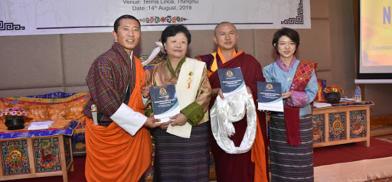Perceived corruption has remained same in the last four years
Even as Bhutan is ranked the 25th cleanest among 180 countries with a score of 68 in the last two years, the perception on the prevalence of corruption in the country has substantially increased over the years, according to the Anti-Corruption Commission’s chairperson Kinley Yangzom

Even as Bhutan is ranked the 25th cleanest among 180 countries with a score of 68 in the last two years, the perception on the prevalence of corruption in the country has substantially increased over the years, according to the Anti-Corruption Commission’s chairperson Kinley Yangzom.
The National Corruption Barometer Report (NCBR) 2020, which was launched yesterday by the ACC chairperson, also revealed that the forms of corruption prevalent in the country and their causes have not changed in the last four years.
“This is a major concern because it clearly indicates that our anti-corruption initiatives need to be ratcheted up to make them more relevant to the fast changing socioeconomic conditions of our country and the world at large,” executive director of Bhutan Transparency Initiative (BTI), Pema Lhamo, said.
When prevalence of corruption is ranked by key service providers, the study found that the ministries topped the list in all of the five most prevalent forms of corruption—trading in influence, failure to declare a conflict of interest, abuse of function, bribery, and embezzlement.
The study has shown that trading in influence is perceived as the number one form of corruption across all service providers by the people. It was also found that the different forms of corruption are interrelated, whereby there is a high prevalence of trading in influence, also a higher prevalence of failure to declare conflict of interest.
“To a large extent, this finding corroborates the results of the Corruption Barometer Survey of 2016 wherein the most common form of corruption reported were nepotism and favouritism, and misuse of public funds, properties and assets,” the report stated.
The survey also found that the perception on bribery as an offence of corruption remained the same at 20.4 percent. Not many, however, believed that money laundering and concealment of corruption proceeds are prevalent in the country.
The study also revealed that the government ministries, corporations, financial institutions and their executives who are the main implementers of public policies and programmes are perceived to be the most corrupted.
A whopping 72 percent perceived that insatiable wants, followed by low moral values, and strong protective social net of the accused as the main causes of corruption.
“A small close-knit society like ours that puts social harmony and integrity in the forefront of all our socio-economic development must ensure that the public organisations and public servants uphold the highest standards of governance at all times,” Pema Lhamo said.
The study also found that corruption is predominantly concentrated at the executive level of all organisations; 31.5 percent of the respondents believe corruption has increased in the last three years and is a very serious problem in the country.
Among the dzongkhags, the highest percentage of the respondents who expressed that the corruption has increased in the past three years was Paro with 64 percent, followed by Thimphu and Pemagatshel with 57.7 percent and 56 percent respectively.
The lowest percentage of the respondents who reported that corruption has increased is Tsirang with 26.7 percent.
And 60.3 percent of the respondents mentioned that they would vote for clean political candidates and parties or avoid/refuse to pay bribes or report corruption.
Those who hold the view that corruption can be bought by voting for clean candidates and parties shot up from 11 percent in 2016 to 60 percent in 2020.
Study methodology
BTI conducted the study with financial support from ACC to understand the corruption situation in the country based on the perception of the citizens and to establish a reference point for awareness, education, and advocacy to reduce corruption in the 12th plan and beyond.
The study was carried out using the embedded correlational model to assess citizens’ perception of corruption. The overall methodology for the study was adapted from Transparency International’s (TI) Global Corruption Barometer Survey (GCBS).
NCBR stated that some of the parameters that were considered for the study centered around forms, causes, concentration, and levels of corruption in the country. The data were collected via mobile tablets using open-source software Open Data Kit Technology.
A total of 1,152 respondents (68 percent from rural areas and 32 percent from urban areas were interviewed.
The samples were drawn from all sections of the Bhutanese society. They consisted of civil servants, parliamentarians, business people, private employees, corporate employees, armed forces personnel, housewives, students, and local government employees, members of the religious institutions and the employees of non-governmental organisations, among others.
Based on the findings, BTI proposed 10 recommendations to the authorities concerned to improve transparency, accountability and integrity at all levels to effectively reduce corruption in the country.
BTI recommends exploring systems and mechanisms to encourage proactive sharing of information by agencies in public domain; review existing systems for recruitment and performance evaluation of executives across all categories of agencies; and initiate proactive interventions to curb corruption in human resource, construction; and procurement services.
The other recommendations are to enact and implement whistleblower protection act; establish office of the ombudsman to address administrative complaints; and enhance measures to curb corruption in elections.
https://kuenselonline.com/perceived-corruption-has-remained-same-in-the-last-4-years/








Post a Comment